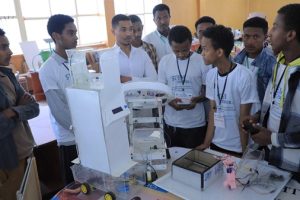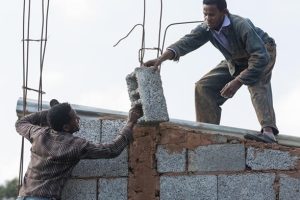Since last weekend, Ethiopians have been rejoicing in the return of the lock of hair of Emperor Tewodros II that had been taken in 1868 following the battle of Maqdala led by the British Army. Recently the diplomatic achievement enables the Ministry of Culture and Tourism (MoCT) to regain the hair from the British National Army Museum. The ministry also pledged to consistently endeavor to return back additional heritages that had been looted in various times.
In addition to this, the ministry also working to conserve the already existing heritages in the country so as to make them more attractive once again so that they can attract more tourists in response.
However, the major problem behind the returning efforts and other tourism infrastructural development is legal framework that contradicts with the countries law, told Gezahegn Abate Ministry’s Public and International Relations Director. In addition, he noted the unknown number of the heritages also affects the returning process. However, the country is working on tourism legal frameworks in order to response to this and other shortcomings in the area, he noted.
According to Tewodros Derbew MoCT Tourism Services Competence Accreditation Director, country’s tourism Master Plan was introduced in 2015 and it will serve until 2025. It is intended to achieve various goals and values including pluralism, social beneficiary, transparency and accountability and coordinated effort among others.
The strategies of the master plan comprised broad-based tourism development, expanding the existing and new tourism destinations and capacity building such as human resource development, marketing and promotion, synergy or partnership.
Tourism development should be sustainable in lined with environment and social beneficiary, adopted system, the necessary input and output. The objectivity of the plan rely on policy, regulation and institutional framework, tourism product development, integrated work with neighboring countries, tourism marketing, branding and promoting, tourism research, safety and security, conservation of natural and social destinations and tourism financing among others, he noted.
“We have plenty of natural and social tourism resources. This ranges from Dalol or Danakil depression (the lowest) to Dashen Mountain, the peak of country’s topography. Numerous fauna and flora from this plenteous natural environment can attract more tourists from the globe. Even in Addis Ababa, we can develop extra tourism attractions like rock climbing, thermal and community based tourism, and running, among others.”
As to him the master plan puts directions to conduct marketing and promotion activities that help to promote the nation to the world. This needs a wide budget and close cooperation efforts among stakeholders, therefore the master plan would help to this end.
The master plan intends to expanding local, continental and international markets. Currently, Ethiopia’s markets are Europe, America, Middle East and some emerging states from Asia. However, the nation must focus on enhancing middle class and developing countries markets as they will have better economy and the upcoming tourists bearers, Tewodros said.
The country wants to facilitate preconditions in which a tourist can visit Ethiopia together with its neighbors at once. This package can comprise Kenya, Uganda, Eritrea and Ethiopia to be visited by using a single ticket. Therefore, both the visitor and destination countries will be merited from such system. The countries would be benefited from the system as it allow them to be interconnected in infrastructure and services in order to get better earnings, he disclosed.
In this regard, the IGAD and the AU have such plan and they are working to liberalize people’s movement by curbing barriers thereby to realize tourism and trade development. Consequently, the master plan is also drafted in a way it can be worked in line with the continental and regional programs.
Today, tour operators from neighboring countries such as Kenya and Djibouti are experiencing the value of cooperative effort. As to him, the tour operators even exchange guests/tourists. “It is possible to sell Africa’s tourism products as a single package. But it needs monetary system and visa services revision and facilitation where our country is working on it.”
However, Ethiopia’s tourism infrastructure and superstructure (tourist facilities) is poor having lack of road, toilets and guest houses, lodges, hotel and internet. Therefore, the master plan is a significant measure to intensify the facilitation efforts in this regard by curbing sector’s shortcomings or hindering factors.
As to him, the major challenges in the area were infrastructural restraints, the delay bureaucracy to get license, and poor ease of business doing process among others. Therefore, the ministry works together with stakeholders to improve infrastructural facilitation, license handover and ease business making activities among others and the master plan is also outlined in this way.
It also outlined directives to realize cultural development. According to Gebriel Asfaw, Cultural Development Adviser at the Ministry, culture is the output and reflection of knowledge, skill, interaction and others in a given society. Country’s tourism policy outlined to develop the culture of nation and nationalities, mutual values and to transfer them to the next generation safely.
Recently, a media forum that briefs the media about the ministry efforts of tourism development and the legal frameworks it has been implemented to achieve the activities was organized here in Addis Ababa. On the occasion, Culture and Tourism Minister Dr. Hirut Kassaw noted that in this globalization period where everyone has a direct exposure and involvement in the media especially via the online medium, the dissemination of accurate information is a key tool in the development of tourism and other sectors.
She noted that the media can play an important role through releasing meaningful information about the significant cultural values of the society via languages of listener’s choice. As to her the media can also convey a message of diversity as a source of beauty and wisdom. It is also helpful to teach the cultural values such as tolerance, mutual coexistence and cooperation to the wider audience.
Today the country is facing serious conflict of ideas due to the low attention given to the traditional mediation values. Similarly the media aggravates such conflicts than finding out solutions from elders and cultural experts on the way how the nation has passed through solving such conflicts intelligently and diligently. The ministry has been endeavoring in identifying, studying and documenting cultural values of the society. However, the media mostly prefer to magnify minor conflicts, he stated.
As to her today the social media provokes quarrels and magnify it led by some elements. It has been disseminating globalized information that might even radiate negative ray in the heart of the innocent youth. This and other impacts triggers the youth to intend to live complaining his/her country and attempts to find opportunities to live abroad, among other causes, that’s why migration has been increasing through time. In this regard the media must set a peaceful agenda and stabilize the political turmoil. Therefore, the day’s program is intended to awake the media to stand for cultural development and keep the youth from the negative impacts of globalization including cultural invasion.
The Ministry of Culture and Tourism has secured some 1.4 billion USD from 380,376 visitors over the past six months. However, the earning seems still low compared to country’s potential. Therefore, curbing problems related to infrastructure, tourist services and marketing drawbacks is significant to achieve more income. To this end, realizing the master plan in lined with other laws and intended parties including the media are a key measure to the sector development.
Herald March 26/2019
BY YOHANES JEMANEH 94





